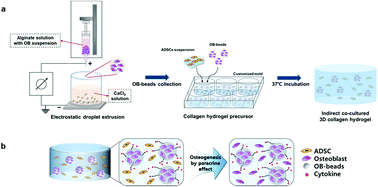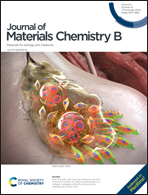A novel 3D indirect co-culture system based on a collagen hydrogel scaffold for enhancing the osteogenesis of stem cells
Abstract
In this study, the paracrine effect between adipose-derived mesenchymal stem cells (ADSCs) and osteoblasts was investigated in collagen-based three-dimensional (3D) scaffolds. 3D encapsulation of mesenchymal stem cells in hydrogel scaffolds was conducted for bone tissue regeneration. Osteoblasts were encapsulated in alginate microbeads with uniform size, which could be controlled by varying the supply voltage using electrostatic droplet extrusion. Osteoblast-encapsulated microbeads were embedded with ADSCs in collagen bulk hydrogel scaffolds with a high survival rate. The separated space between the two types of cells made it possible to confirm ADSC differentiation into osteogenic lineages in the 3D collagen hydrogel scaffold by the paracrine effect in vitro. Furthermore, co-cultured ADSC and osteoblasts showed enhanced bone formation compared with the ADSC monoculture group in the rat calvarial defect model. The system developed in this study provides a novel in vitro tissue model for bone regeneration without exogenous factors, and it has the potential to be used to study the paracrine effect in various co-culture systems in the near future.

- This article is part of the themed collection: Journal of Materials Chemistry B Lunar New Year collection 2021


 Please wait while we load your content...
Please wait while we load your content...